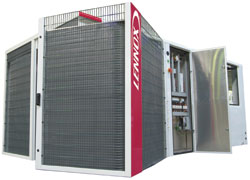Packaged rooftop units have traditionally been seen as a poor cousin to other systems. But it’s time to take a fresh look at the latest generation, says David Birtles, director of Lennox UK
One of the key challenges facing air-conditioning specifiers these days is the need to provide a system that will cope with rising ambient temperatures without sending carbon emissions through the roof. The only way to address these conflicting pressures is to get smarter and more flexible.
This requires a joint approach from the parties involved.
Manufacturers need to ensure their products incorporate the latest performance-enhancing technologies. And those who design the systems and select the equipment need to be aware of new developments and keep an open mind.
Packaged rooftop units are a case in point. Traditionally, these have been seen as a cheap and cheerful alternative to a chiller or air handling unit combination. They may, on first appearance, lack the precise but complicated control characteristics of the latter but make up for it through low cost and ease of installation. Unfortunately, this perception leads to low expectations for these packaged air systems on the part of the specifier and end user. And, until recently, it did little to encourage packaged-unit manufacturers to raise their game.
A smart and flexible strategy brings a different perspective. There are still many projects where packaged rooftop units are the ideal choice.
So, a sensible approach will exploit their low-cost and ease-of-use benefits while delivering enhanced performance. As a result, the installer and the end user get the best of both worlds.
In sourcing a smart and flexible packaged rooftop unit, there are a number of factors to consider. For example, there is no good reason why a packaged air system cannot use the same double aluminium skin construction you would expect to find in an ahu. This would enable packaged units to play a dual role, taking care of both conditioning the air and distributing it.
This construction method would also help to retain the low weight that is necessary for many rooftop installations. In fact, with the trend towards lighter building structures, and the increased use of helicopters to speed up the installation, it is vital to keep the weight of these units as low as possible.
Through extensive use of aluminium, for example, the new Lennox Flexy II range is 42% lighter than some competitors. And yet it offers performance to 230kW. And the largest units have a maximum airflow of 43,000m3/h and external static pressure up to 600Pa.
That said, it would be a mistake to think that these units can only be used on rooftops. In fact, the lower-noise models can be installed just about anywhere outside a building. To increase ease and speed of installation, the units should be self-supporting with no need for a support frame. On a rooftop, they should also incorporate an adjustable roofcurb, and be fitted with supply-and-return openings designed to minimise resistance and pressure drop.
Energy performance is also a vital consideration. And there is far more to efficiency than the coefficient of performance (COP) of the compressor at full load. Yet gross COP still forms the basis of many such calculations. And cooling plant is still sized to cope with the hottest few days of the year.
It is more meaningful to consider the part-load efficiencies that will prevail for most of the year. And this is why Seasonal Energy Efficiency Rates are becoming a more important measure across Europe. Part-load efficiencies are influenced by many factors. So, gaining a clear picture of performance requires a detailed look at every aspect of the equipment. This is where the smart, flexible approach to specification ties up with the smart, flexible units that specifiers and end-users should be demanding.
For example, a major contributor to the energy consumption of a rooftop unit is the supply fan. So, replacing traditional centrifugal fans with more efficient electronically commutated plug fans can make a big difference to overall efficiency.

Packaged rooftop units are rapidly diversifying into non-retail sites
The performance of the compressors is also important, of course, and the use of two scroll compressors operating in tandem will provide greater efficiencies at part-load while maintaining a high COP at full load. A free cooling option contributes further to energy savings.
Other factors to consider include dynamic defrost, heat-recovery capabilities, the ability to provide heating and cooling at low ambient temperatures, and the flexibility to use dual-fuel or modulating gas burners as the most appropriate heating options. Lifecycle costs will also be affected by issues such as ease of maintenance.
There are, in fact, so many factors to consider that it is easy to overlook some of them. But specially designed software can take care of calculations, such as average daily temperatures, and predict the likely benefits of including features that go beyond the basic rooftop package. So, specification decisions can be based on meaningful information.
It is not surprising, therefore, that more and more applications are finding packaged rooftops ideal. As a result, they are no longer confined to retail sites, and are rapidly diversifying into casinos, clubs, restaurants, petrol stations, fast-food outlets, cinemas, car showrooms, offices, sports arenas, health clubs etc. This is a trend we can expect to continue as packaged air systems get smarter and more flexible.
www.lennoxeurope.com